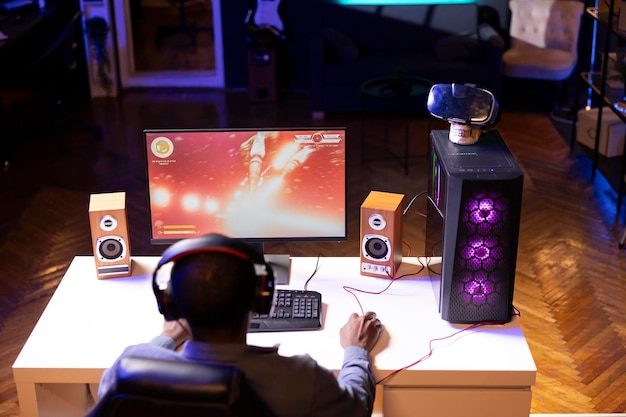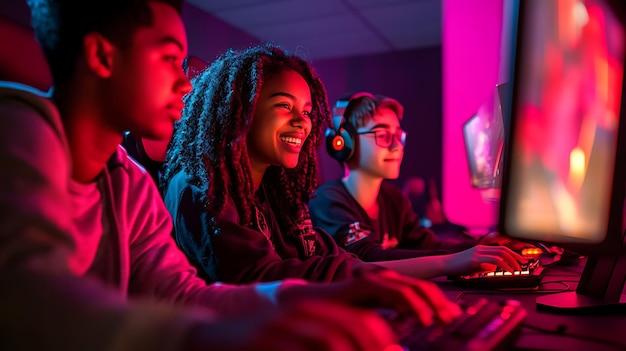
VR/AR Game Development
Build immersive experiences for virtual and augmented reality platforms using cutting-edge technology
About This Training Program
This comprehensive program covers VR fundamentals, motion sickness mitigation, and comfort design principles. Students learn hand tracking implementation, spatial audio design, and locomotion systems that work across different VR platforms and user capabilities.
The curriculum includes AR marker detection, plane finding, and persistent cloud anchors. Participants develop for Meta Quest, HoloLens, and mobile AR platforms, gaining practical experience with the tools and frameworks used in professional XR development.
Perfect for developers entering XR development or expanding into immersive media. The program emphasizes creating comfortable, accessible experiences while exploring the unique design opportunities these platforms provide.
Career Advancement Opportunities
Emerging Technology
Position yourself at the forefront of immersive technology development, gaining expertise in platforms that represent the future of interactive entertainment and training applications.
Hands-On Projects
Build three substantial projects showcasing your XR capabilities: VR training simulation, AR location-based game, and mixed reality experience suitable for portfolio presentation.
Cross-Platform Skills
Learn to develop for multiple XR platforms including standalone headsets, mobile AR, and enterprise devices, expanding your capabilities across the immersive technology spectrum.
Industry Connections
Connect with other XR developers and industry professionals during the program, building relationships within the growing immersive technology community in.
Development Tools & Platforms
VR Platforms
- Meta Quest 2 and Quest 3 development
- SteamVR for PC-connected headsets
- OpenXR cross-platform framework
AR Frameworks
- ARKit for iOS development
- ARCore for Android platforms
- Microsoft HoloLens Mixed Reality Toolkit
Development Engines
- Unity XR Interaction Toolkit
- Unreal Engine VR templates
- WebXR for browser-based experiences
Interaction Systems
- Hand tracking and gesture recognition
- Spatial audio and 3D sound design
- Haptic feedback implementation
User Comfort & Design Standards
Motion Comfort Guidelines
Learn to design experiences that minimize motion sickness through proper frame rate maintenance, reduced artificial locomotion, and comfortable field of view settings. The program covers techniques for identifying and mitigating comfort issues before they affect users.
Students explore various locomotion systems including teleportation, smooth movement with comfort options, and room-scale experiences. Understanding individual comfort variations helps create experiences accessible to broader audiences.
Accessibility Considerations
The curriculum addresses designing for users with different physical abilities, ensuring experiences remain enjoyable regardless of mobility constraints or height variations. Participants learn to implement seated modes, adjustable interaction distances, and alternative control schemes.
Students explore audio alternatives for visual elements, visual cues for audio feedback, and customizable control mappings. These techniques expand potential user bases while improving experience quality for all participants.
Performance Optimization
Master techniques for maintaining consistent frame rates across different devices, critical for comfortable VR experiences. The program covers level of detail systems, occlusion culling, and efficient rendering approaches specific to stereoscopic displays.
Learn to profile XR applications, identify performance bottlenecks, and implement optimization strategies. Understanding platform-specific constraints helps create experiences that perform well on target hardware.
Who This Program Supports
Traditional Developers
Programmers with game development experience who want to expand into immersive platforms, learning the unique considerations and opportunities VR and AR technologies offer.
Creative Technologists
Artists and designers interested in creating interactive installations, experiential marketing, or immersive storytelling using XR technologies for commercial or artistic applications.
Enterprise Developers
Professionals developing training simulations, visualization tools, or productivity applications for business contexts where immersive technologies provide practical advantages.
Learning Progress & Assessment
The program progresses through platform fundamentals, interaction design, and advanced implementation techniques. Students build increasingly complex projects throughout the curriculum, demonstrating mastery of core concepts.
Each project receives detailed feedback on comfort design, interaction quality, and technical implementation. Final portfolio pieces demonstrate readiness to create professional-quality XR experiences.
Enter the World of Immersive Development
Join developers building experiences for the next generation of interactive platforms through comprehensive VR and AR training
Questions about the program?
Contact us at info@sorquielwing.com or call +81 422-60-8088
Explore Other Training Programs

Multiplayer Game Architecture
Design and implement robust multiplayer systems for competitive and cooperative gaming experiences

Game Economy Design
Create balanced and engaging virtual economies that drive player retention and monetization